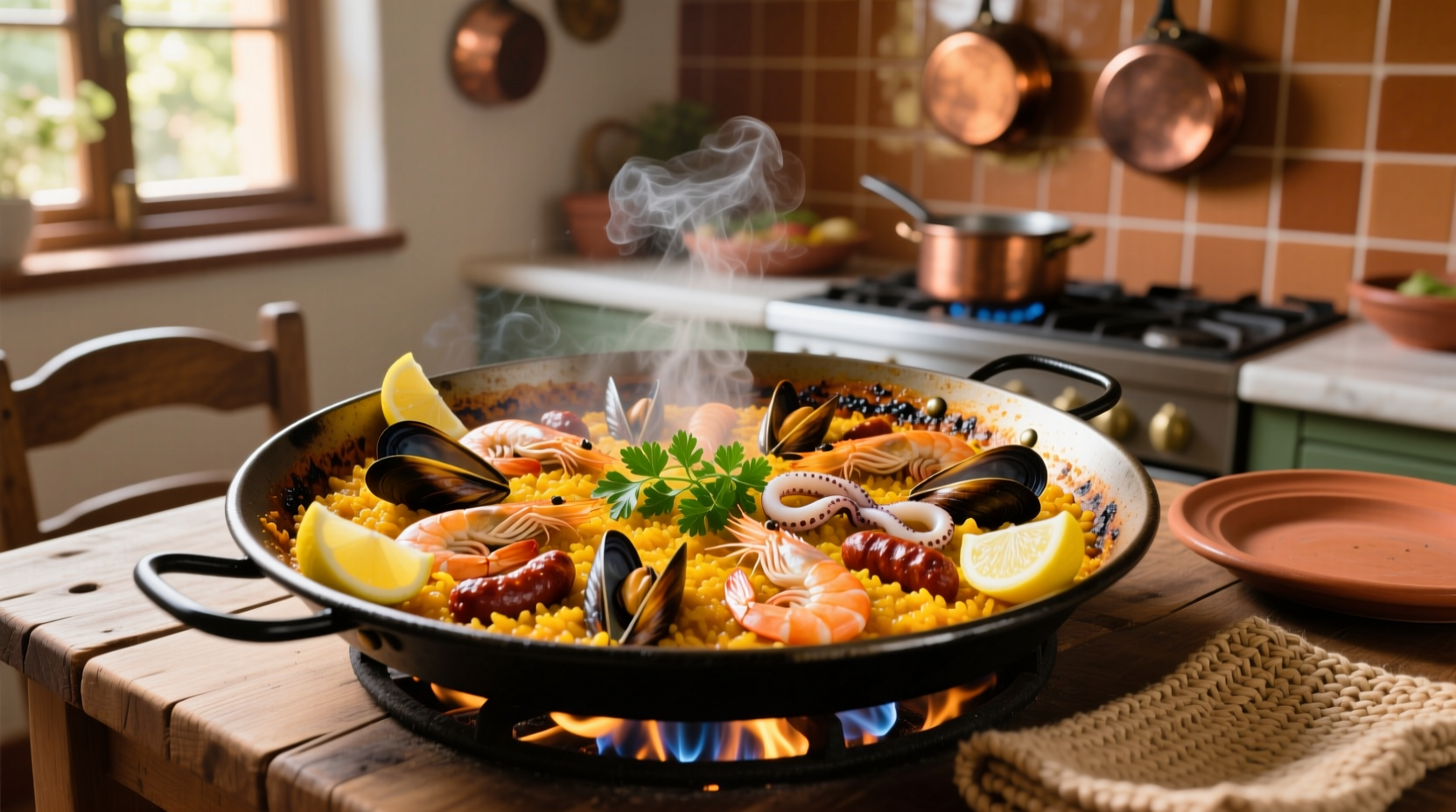Creating authentic Spanish paella starts with understanding its Valencian roots and essential techniques. This iconic dish requires precise rice-to-liquid ratios, proper heat management, and respect for traditional ingredients. Forget the common mistakes of stirring the rice or using the wrong pan - authentic paella develops its signature socarrat (caramelized bottom layer) through careful temperature control and patience. With the right approach, you'll achieve restaurant-quality results featuring saffron-infused rice, tender proteins, and that coveted crispy bottom layer.
The Evolution of Paella: From Farmhouse Staple to Global Icon
Paella's journey began in Valencia's agricultural fields during the Moorish occupation of Spain (8th-13th centuries), where farmers combined locally grown rice with available ingredients. The dish evolved through distinct phases:
| Time Period | Key Developments | Primary Ingredients |
|---|---|---|
| 8th-15th Century | Rice cultivation introduced by Moors | Local rice, seasonal vegetables, rabbit |
| 16th-18th Century | "Paella" name adopted from cooking vessel | Addition of snails, chicken, beans |
| 19th Century | Spread to coastal regions | Seafood varieties emerge |
| 20th Century | Global popularity boom | Mixed paella becomes standard |
According to Spain's Royal Academy of Gastronomy, authentic Valencian paella remains protected by strict guidelines established in 2018, preserving its cultural heritage while allowing for regional variations. The traditional preparation method using a wide, shallow paellera pan over open flame creates the distinctive texture impossible to replicate in standard cookware.
Essential Ingredients: Authentic vs. Common Mistakes
Using the right ingredients in proper proportions makes the difference between authentic paella and a rice pilaf. The Valencian Paella Association specifies exact ratios that home cooks often get wrong:
| Component | Authentic Approach | Common Mistake | Impact on Final Dish |
|---|---|---|---|
| Rice | Bomba or Senia (1 cup rice : 2.5 cups liquid) | Arborio or long-grain rice | Mushy texture, no socarrat formation |
| Saffron | True saffron threads (0.1g per 4 servings) | Saffron powder or turmeric substitute | Artificial flavor, incorrect color development |
| Liquid | Homemade fish/vegetable stock | Water or canned broth | Flat, one-dimensional flavor profile |
| Cooking Method | No stirring after adding rice | Stirring like risotto | Prevents socarrat, creates mushy rice |
Equipment Checklist for Authentic Results
Using proper equipment isn't optional for authentic paella - it's essential for proper heat distribution and texture development:
- Paellera pan: Carbon steel, 15-17 inches diameter (for 4-6 servings)
- Heat source: Gas burner or open flame (induction won't work)
- Rice varieties: Bomba or Senia (never Arborio or jasmine)
- Saffron: True threads soaked in warm stock (not powder)
- Wooden spoon: For initial sofrito, not for stirring rice

Step-by-Step Cooking Process
Follow these precise steps for authentic paella with perfect socarrat:
Preparation Phase (20 minutes)
- Soak saffron threads in 2 tablespoons warm homemade stock for 15 minutes
- Prepare proteins: Cut chicken thighs into 2-inch pieces, clean rabbit, prepare seafood
- Chop vegetables: 1 diced tomato, 1 sliced onion, 1/2 cup green beans, 1/4 cup peas
- Measure rice: 2 cups Bomba rice (rinsed but not soaked)
Cooking Phase (45 minutes)
- Heat 1/4 cup olive oil in paellera over medium-high flame
- Cook proteins until browned (chicken first, then rabbit), remove and set aside
- Add onions and peppers, cook until softened (5 minutes)
- Add tomato, cook until oil separates (8-10 minutes - critical for flavor base)
- Add rice, stir to coat with sofrito (2 minutes)
- Pour in 5 cups warm stock with saffron, arrange proteins evenly
- Simmer uncovered 18 minutes without stirring
- Increase heat for final 3 minutes to develop socarrat
- Rest 5 minutes before serving
Avoiding Common Paella Pitfalls
Even experienced cooks make these critical mistakes that ruin paella:
- Stirring after adding rice: Destroys starch structure needed for socarrat
- Incorrect heat management: Too low = no crust, too high = burnt rice
- Wrong rice variety: Bomba absorbs more liquid without becoming mushy
- Overcrowding proteins: Creates uneven cooking and steam pockets
According to Barcelona's Institut d'Estudis Catalans, the critical temperature range for socarrat development is 325-350°F (163-177°C) during the final minutes. This precise heat creates the caramelized layer without burning. Their research shows that Bomba rice's unique starch composition allows it to absorb 2.5x its volume in liquid while maintaining structural integrity - a ratio impossible with other rice varieties.
Serving and Storage Guidelines
Authentic paella should be served immediately from the cooking pan. The socarrat layer continues developing during the 5-minute resting period, so timing is crucial. Serve family-style with lemon wedges and a simple alioli.
For storage: Refrigerate leftovers within 2 hours in airtight containers. Reheat only once using the oven method - spread paella on baking sheet, mist with stock, cover with foil, and heat at 300°F (150°C) for 10-15 minutes. Never microwave paella as it destroys the delicate texture.
When Substitutions Are Acceptable
Traditionalists maintain strict ingredient requirements, but certain substitutions work in specific contexts:
- Saffron: Acceptable only for budget constraints (use 1/8 tsp paprika + pinch turmeric)
- Seafood paella: Can substitute clams with mussels if unavailable
- Vegetarian version: Replace meat with artichokes and roasted red peppers
- Rice: Never substitute - Bomba is essential for proper texture
The Spanish Ministry of Agriculture notes that while ingredient substitutions exist for accessibility, authentic Valencian paella strictly requires specific local ingredients. Their 2022 culinary preservation report emphasizes that regional variations should respect core techniques even when ingredients differ.











 浙公网安备
33010002000092号
浙公网安备
33010002000092号 浙B2-20120091-4
浙B2-20120091-4